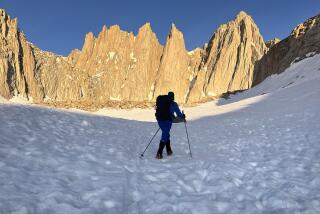Climbing Mt. Kilimanjaro
- Share via
Mt. Kilimanjaro is located on the equator. When Europeans first saw the mountain in 1848, they reported snow at the top. They were not believed. How could there be snow in such a hot place as the equator? Geographers said the white stuff must be salt deposited by the dormant volcano. They didn’t know that the higher the altitude, the colder the air, even at the equator!
As Julie, Carl, and Uncle Bill walked around Moshi in the morning, the air was crisp. Moshi is about 4,000 feet above sea level and they had to get used to the altitude.
Rich volcanic soil from the mountain, fed by clear streams from the glaciers, has produced magnificent coffee for more than a century. Julie, Carl, and Uncle Bill visited the coffee farm owned by Uncle Bill’s friend Hassan near Moshi. Hassan showed them how coffee beans are picked, dried, and then packed in sacks for shipment to market.
In the afternoon they took a brisk walk to prepare themselves for the next day’s climb. Then they rested and watched TV--a soap opera in Swahili, the main language in Tanzania.
At 5 a.m., they set off for three days of climbing. There were 13 in their party, including a leader and three porters. The landscape changed as they climbed slowly, in single file. In the dense forest, they saw elephant dung and black and white colobus monkeys. Then they came to a broad moorland dotted with flowering plants. They picked their way across the stones in the frequent streams. As they emerged above the timberline, they saw many stones covered with lichens and moss.
About a third of the way up, they came to the hut where they spent the night. They slept soundly and felt refreshed as they began the second day of climbing.
Wednesday: The climb gets harder.
Ned Munger is a professor at the California Institute of Technology in Pasadena. He specializes in African history and politics, and has traveled to Africa 88 times. He hopes readers of his story will be able to go to Africa some day. This story will be on The Times’ Web site at www.latimes.comkids.
More to Read
Sign up for The Wild
We’ll help you find the best places to hike, bike and run, as well as the perfect silent spots for meditation and yoga.
You may occasionally receive promotional content from the Los Angeles Times.






